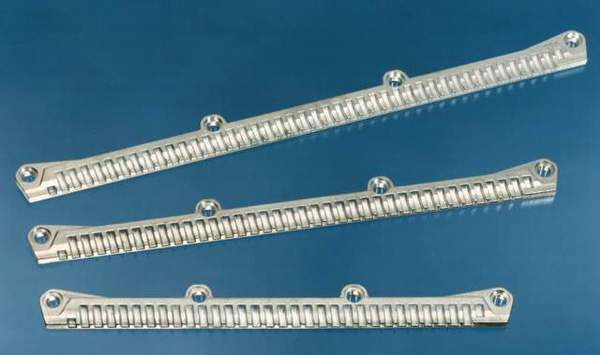Casting Study: Gear Rack and Housing
 One of the first opportunities to test ACuZinc 5 was in Delphi Interior and Lighting System’s newly-designed heliscrew horizontal actuator for power seats. The die castings replace a powder-metal gear rack and plastic gear housing design. Seat adjustment is comparable in smoothness to earlier pinion-gear actuators, but operates 30-percent faster. The rack is attached to a stationary lower channel and the housing is secured to an upper sliding channel. The housing accommodates a worm-to-helix reduction gear. Although a steel gear is mated to the AcuZinc gear rack, the part exhibits greater wear resistance because of its lower coefficient of friction. For the same reason, a bearing insert was eliminated from the housing.
One of the first opportunities to test ACuZinc 5 was in Delphi Interior and Lighting System’s newly-designed heliscrew horizontal actuator for power seats. The die castings replace a powder-metal gear rack and plastic gear housing design. Seat adjustment is comparable in smoothness to earlier pinion-gear actuators, but operates 30-percent faster. The rack is attached to a stationary lower channel and the housing is secured to an upper sliding channel. The housing accommodates a worm-to-helix reduction gear. Although a steel gear is mated to the AcuZinc gear rack, the part exhibits greater wear resistance because of its lower coefficient of friction. For the same reason, a bearing insert was eliminated from the housing.
In this new seat design, the inboard seat belts are attached directly to the seat instead of the vehicle body. In a crash situation, seat belt loads are transferred through the seat adjusting mechanism to the lower channel, which is fastened to the vehicle floor. As a result, the rack and housing must withstand high loads at high strain rates. Testing confirms the ACuZinc die castings meet all performance requirements. Load-to-fracture increased more than four-fold over the original design. The components are die cast net shape. Other than removing the gating system, no secondary operations are performed. The gear racks have a flatness tolerance of 0.020 in. (0.5mm) along the entire length, a true position specification of 0.008 in. (0.2mm) on the mounting holes and a complex gear profile. Other benefits include excellent surface finish and high production rates with low scrap levels.